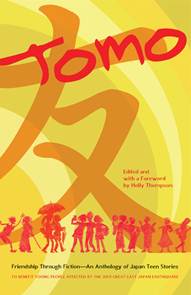Tomo: Friendship through Fiction: An Anthology of Japan Teen Stories. ed. by H. Thompson
DOI:
https://doi.org/10.20361/G2WK5GAbstract
Thompson, Holly (editor). Tomo: Friendship through Fiction: An Anthology of Japan Teen Stories. Berkeley, CA: Stone Bridge Press, 2012. Print.
Shortly after the Great East Japan Earthquake (and tsunami) of 11 March 2011, Holly Thompson came up with a unique idea to contribute to the recovery. The resulting anthology of prose, verse, and graphic art stories by authors and artists from around the world who share a connection to Japan will generate some financial help to support young people affected by this disaster. More importantly, it will contribute to a deeper understanding of, and connection to, what is still a surprisingly mysterious culture.
Despite Japan’s status as one of the largest and most successful world-economies, despite our familiarity with sushi and karaoke and judo and samurai and multitudinous Japanese brand-names, so much of Japanese culture as it is lived on the ground and in people’s minds is a complete mystery even to experienced Japan-hands and Japanese themselves.
This anthology, as a whole and above all else, highlights the mysteriousness. While each of the 36 individual stories might evoke a response like, “Really? So that’s what it’s all about” (“ahh, sō desuka”) or “Ah, now I get it!” (“ahh, naru hodo”), the effect of reading them all is more like, “hmm, there is nothing simple about Japan after all. I need to know more.” There is something for everyone, Japanophiles and those with no familiarity whatsoever. More precisely, there is something for everyone in each story.
Japanese culture is wildly diverse and complicated when viewed even just through teenage and young adult eyes, as are most stories in this collection. That, I think, is the true value of this collection. It doesn’t boil Japanese-ness down to trite generalizations. It doesn’t play to the notion of a vast, homogenous culture of uniformity and a lack of individuality. It doesn’t leave the reader with a feeling of having it all summed up.
If I have one minor and very personal quibble, it is perhaps too many stories with a haafu (half-Japanese) character reflecting on how tough life is when you’re not pure Japanese. Having said that, there is not one single story I could have rejected or would suggest skipping over – they are each individually poignant and insightful.
I also recommend following up on the Tomo anthology website with its blog featuring contributor interviews, information about sales proceeds, and soon-to-be-added supplementary educational materials. http://tomoanthology.blogspot.ca.
I should mention a few personal connections. I lived in the Tohoku region and have many friends there. Also, an excerpt from my translation of a Japanese poem appears in the anthology and an interview appears on the blog site. Be assured I would not recommend Tomo if I had any hesitations whatsoever. In fact, I was wary when first contacted as I’d just heard of a shady fund-raising scheme capitalizing on the tragedy; contact with Holly Thompson quickly allayed my concerns. My only benefits in reviewing and recommending this book are the satisfaction of increasing awareness of Japan’s fascination, making connections with interesting people, and offering a small support to the people of Tohoku.
Recommended: 4 out of 4 stars
Reviewer: David Sulz
David is a Public Services Librarian at University of Alberta and liaison librarian to Economics, Religious Studies, and Social Work. He has university studies in Library Studies, History, Elementary Education, Japanese, and Economics; he formerly taught in schools and museums. His interests include physical activity, music, home improvements, and above all, things Japanese.

Published
How to Cite
Issue
Section
License
Authors who publish with this journal agree to the following terms:
- Authors retain copyright and grant the journal right of first publication with the work simultaneously licensed under a Creative Commons Attribution License that allows others to share the work with an acknowledgement of the work's authorship and initial publication in this journal.
- Authors are able to enter into separate, additional contractual arrangements for the non-exclusive distribution of the journal's published version of the work (e.g., post it to an institutional repository or publish it in a book), with an acknowledgement of its initial publication in this journal.
- Authors are permitted and encouraged to post their work online (e.g., in institutional repositories or on their website) prior to and during the submission process, as it can lead to productive exchanges, as well as earlier and greater citation of published work (See The Effect of Open Access).






